York railway station
York railway station is on the East Coast Main Line in the United Kingdom, serving the city of York, North Yorkshire. It is 188 miles 40 chains (303.4 km) north of London King's Cross and on the main line it is situated between Doncaster to the south and Thirsk to the north. As of June 2018, the station is operated by London North Eastern Railway.[2]
.jpg.webp) | |
| Location | York, City of York England |
| Coordinates | 53.9583°N 1.0930°W |
| Grid reference | SE596517 |
| Owned by | Network Rail |
| Managed by | London North Eastern Railway |
| Platforms | 11 |
| Other information | |
| Station code | YRK |
| Classification | DfT category A |
| Key dates | |
| 25 June 1877 | Opened |
| 1909 | Extended |
| Passengers | |
| 2015/16 | |
| Interchange | |
| 2016/17 | |
| Interchange | |
| 2017/18 | |
| Interchange | |
| 2018/19 | |
| Interchange | |
| 2019/20 | |
| Interchange | |
Listed Building – Grade II* | |
| Feature | Station buildings |
| Designated | 1 July 1968 |
| Reference no. | 1256554[1] |
| Notes | |
Passenger statistics from the Office of Rail and Road | |
York station is a key junction approximately halfway between London and Edinburgh. It is approximately five miles north of the point where the Cross Country and TransPennine Express routes via Leeds join the main line, connecting Scotland and the North East, North West, Midlands and southern England. The junction was historically a major site for rolling stock manufacture, maintenance and repair.
In Britain's 100 Best Railway Stations by Simon Jenkins, the station was one of only ten to be awarded five stars.[3]
History
The first York railway station was a temporary wooden building on Queen Street outside the walls of the city, opened in 1839 by the York and North Midland Railway. It was succeeded in 1841, inside the walls, by what is now York old railway station.[4] In due course, the irksome requirement that through trains between London and Newcastle needed to reverse out of the old York station to continue their journey necessitated the construction of a new through station outside the walls.
The present station, designed by the North Eastern Railway architects Thomas Prosser and William Peachey, opened on 25 June 1877. It had 13 platforms and was at that time the largest in the world.[5] As part of the new station project, the Royal Station Hotel (now The Principal York), designed by Peachey, opened in 1878.
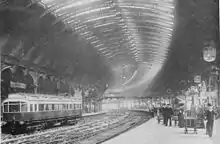
In 1909 new platforms were added, and in 1938 the current footbridge was built and the station resignalled.
The building was heavily bombed during the Second World War.[6] On one occasion, on 29 April 1942,[7] 800 passengers had to be evacuated from a King's Cross-Edinburgh train which arrived during a bombing raid.[6] On the same night, two railway workers were killed, one being station foreman William Milner (born 1900[7]), who died after returning to his burning office to collect his first aid kit. He was posthumously awarded the King's commendation for gallantry.[7] A plaque in his memory has been erected at the station.[6][7] The station was extensively repaired in 1947.
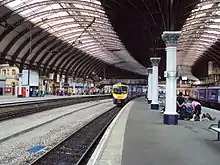
The station was designated as a Grade II* listed building in 1968.[1]
The track layout through and around the station was remodelled again in 1988 as part of the resignalling scheme that was carried out prior to the electrification of the ECML shortly afterwards by British Rail. This resulted in several bay platforms (mainly on the eastern side) being taken out of service and the track to them removed. At the same time a new signalling centre (York IECC) was commissioned on the western side of the station to control the new layout and also take over the function of several other signal boxes on the main line. The IECC here now supervises the main line from Temple Hirst (near Doncaster) through to Northallerton, along with sections of the various routes branching from it. It has also (since 2001–2) taken over responsibility for the control area of the former power box at Leeds and thus signals trains as far away as Gargrave and Morley.
In 2006–7, to improve facilities for bus, taxi and car users as well as pedestrians and cyclists, the approaches to the station were reorganised. The former motive power depot and goods station now house the National Railway Museum.
Stationmasters
- Edward Oates ca 1850–1880
- William Lackenby 1880–1890[8]
- John Bradford Harper 1890[9] - 1893
- Samuel Holliday 1893–1897 (afterwards stationmaster at Newcastle)
- James Brown 1897–1902
- William Thompson 1902–1913 (afterwards stationmaster at Newcastle)
- Thomas Clements Humphrey 1913–1923 (afterwards stationmaster at Newcastle)
- Frank Wilfred Wheddon 1923[10] - 1926
- Harry A. Butcher 1926[11]–1932 (afterwards stationmaster at Newcastle)
- George W. Pattinson 1932[12]–1939
- E.O. Wright 1941–1946[13]
- G. W. Anson 1946[14]–1949
- W.H. Burton 1949–1950 (afterwards station master at Newcastle)
- Harold Gardner 1950[15]–1953
R. A. Tomlinson 1953 - 2018
K Jaswal 2018 - 2020
H Carlton 2020 -
Accidents and incidents
- On 31 March 1920, a passenger train was derailed as it entered platform 8.[16]
- On 5 August 1958, a passenger train crashed into the buffers at platform 12.[16]
- On 18 January 2006, a freight train wagon derailed on points entering platform 3 before re-railing 400 sleepers later causing extensive damage to trackworks through the station. The derailment happened due to faulty suspension on one of the bogies causing the load to sit unevenly across the axles, lifting the axle off the tracks as it went round the corner over the points.[17]
Layout
All the platforms except 9, 10 and 11 are under the large, curved, glass and iron roof. They are accessed via a long footbridge (which also connects to the National Railway Museum) or via lifts and either of two pedestrian tunnels.[18] Between April 1984 and 2011 the old tea rooms housed the Rail Riders World/York Model Railway exhibition.[19]
Major renovation
The station was renovated in 2009. Platform 9 has been reconstructed and extensive lighting alterations were put in place. New automated ticket gates (similar to those in Leeds) were planned, but the City of York Council wished to avoid spoiling the historic nature of the station. The then operator National Express East Coast planned to appeal the decision but the plans were scrapped altogether upon handover to East Coast.[20]
Recent developments
The southern side of the station has been given new track and signalling systems. An additional line and new junction was completed in early 2011. This work has helped take away one of the bottlenecks on the East Coast Main Line.[21]
The station has also become the site of one of Network Rail's modern Rail Operation Centres, which opened in September 2014 on land to the west of the station[22] This took over the functions of the former IECC in December 2018 and will eventually control much of the East Coast Main Line from London to the Scottish border and various subsidiary routes across the North East, Lincolnshire and South, North and West Yorkshire.
York Central
Located adjacent to the station, York Central is one of the largest city centre brownfield regeneration sites in the UK. The 45 hectare site has been designated as a UK Government ‘Housing Zone’ and has also been awarded ‘Enterprise Zone’ status, which offers commercial occupiers significant incentives. Outline planning approval was given for the site in March 2019. It is anticipated that development of the full site could take between 15 and 20 years to complete.[23]
Platforms

The platforms at York have been renumbered several times, the most recent being in the late 1980s to coincide with a reduction in the number of platforms from 15 to 11. The current use is:[24]
- Platform 1: South-facing bay platform mostly used for services to Hull or Sheffield via Moorthorpe and for stabling empty stock.
- Platform 2: North-facing bay platform connected only to the Scarborough branch, used mostly for stabling a spare TransPennine Express unit along with the accompanying station siding.
- Platform 3: Main southbound platform, but is signalled bi-directionally, accessible directly from the station concourse. Fast and semi-fast southbound London North Eastern Railway for London King's Cross generally use this platform. CrossCountry services, Grand Central and some westbound TransPennine Express services also use it.
- Platform 4: Northward continuation of platform 3 connected only to the Scarborough branch, used by TransPennine Express services from Scarborough.
- Platform 5 (split into 5a and 5b): Main northbound platform (but is signalled bi-directionally). Fast northbound London North Eastern Railway services to Scotland use this and generally call at Darlington and Newcastle only. Accessible by footbridge or tunnel. Also used by some CrossCountry services northbound. North/eastbound TransPennine Express to Scarborough generally use this platform along with summer Saturday-only East Midlands Railway services to Scarborough. Southbound London North Eastern Railway services also stop here both fast and semi-fast, the latter of which generally call at Doncaster, Newark, Peterborough and London King's Cross.
- Platform 6: South-facing bay platform used mostly by Northern Trains commuter services to Leeds and Blackpool North; by terminating London North Eastern Railway services that return south to London King's Cross; and on non-summer Saturdays by East Midlands Railway services to London St Pancras.
- Platform 7: South-facing bay platform used mostly by Northern commuter services, London North Eastern Railway services to/from London King's Cross starting/terminating at York and non-summer Saturday services by East Midlands Railway to London St. Pancras.
- Platform 8: North-facing bay platform used almost exclusively by Northern Trains on the Harrogate Line.
- Platforms 9, 10, 11: Bi-directional platforms used by semi-fast and some fast London North Eastern Railway services heading north to Newcastle and Scotland, CrossCountry services north and southbound via Leeds, TransPennine Express services westbound to Manchester Piccadilly, Manchester Airport and northbound to Newcastle and Redcar. Some Northern Trains services to Blackpool also use this platform.
Platforms 10 and 11 are outside of the main body of the station. Another siding, the former fruit dock, exists opposite platform 11.
Services
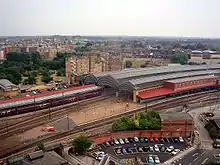
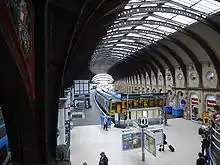
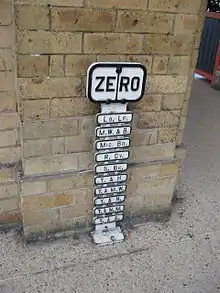
The station is operated by London North Eastern Railway and is used by the following train operating companies:
London North Eastern Railway
London North Eastern Railway operates regular services that stop at York between London, Newcastle and Edinburgh. In addition, there are infrequent services to Glasgow, Aberdeen and Inverness. The fastest southbound services run non-stop to London, completing the 188 mile journey in 1 hour and 52 minutes.[25]
Rolling stock used: Inter-City 225 (Class 91 electric locomotive & DVT), Class 800 bi-mode trains and Class 801 electric trains
CrossCountry
CrossCountry provides a number of services that run across the country, running as far north as Aberdeen and south as Penzance and Southampton Central via Birmingham New Street.[26]
Rolling stock used: Inter-City 125 (HST), Class 220 and Class 221 Voyager diesel multiple units.
East Midlands Railway
East Midlands Railway provides one weekend return journey between York and London St Pancras via the Midland Main Line, as well as one summer Saturday journey to/from Scarborough.[27]
Rolling stock used: Class 222 Meridian diesel multiple units and, very rarely on railtours, InterCity 125s.
TransPennine Express
TransPennine Express provides a number of express services across the north of England (to Manchester Piccadilly, Liverpool Lime Street, Newcastle, Scarborough and Middlesbrough).[28]
Rolling stock used: Class 185 Pennine diesel multiple units, Class 68 locomotives with Mark 5a coaching stock and Class 802 bi-mode trains
Grand Central
Grand Central runs an open access service between Sunderland and London.[29]
Rolling stock used: Class 180 Adelante trains.
Northern Trains
Route 29: Harrogate Line | |||||||||||||||||||||||||||||||||||||||||||||||||||||||||||||||||||||||||||||||||||||||||||||||||||||||||
|---|---|---|---|---|---|---|---|---|---|---|---|---|---|---|---|---|---|---|---|---|---|---|---|---|---|---|---|---|---|---|---|---|---|---|---|---|---|---|---|---|---|---|---|---|---|---|---|---|---|---|---|---|---|---|---|---|---|---|---|---|---|---|---|---|---|---|---|---|---|---|---|---|---|---|---|---|---|---|---|---|---|---|---|---|---|---|---|---|---|---|---|---|---|---|---|---|---|---|---|---|---|---|---|---|---|
| |||||||||||||||||||||||||||||||||||||||||||||||||||||||||||||||||||||||||||||||||||||||||||||||||||||||||
Route 34: York to Hull and Sheffield | |||||||||||||||||||||||||||||||||||||||||||||||||||||||||||||||||||||||||||||||||||||||||||||||||||||||||||||||||||||||||||||||||||||||||||||||||||||||||||||||||
|---|---|---|---|---|---|---|---|---|---|---|---|---|---|---|---|---|---|---|---|---|---|---|---|---|---|---|---|---|---|---|---|---|---|---|---|---|---|---|---|---|---|---|---|---|---|---|---|---|---|---|---|---|---|---|---|---|---|---|---|---|---|---|---|---|---|---|---|---|---|---|---|---|---|---|---|---|---|---|---|---|---|---|---|---|---|---|---|---|---|---|---|---|---|---|---|---|---|---|---|---|---|---|---|---|---|---|---|---|---|---|---|---|---|---|---|---|---|---|---|---|---|---|---|---|---|---|---|---|---|---|---|---|---|---|---|---|---|---|---|---|---|---|---|---|---|---|---|---|---|---|---|---|---|---|---|---|---|---|---|---|---|
| |||||||||||||||||||||||||||||||||||||||||||||||||||||||||||||||||||||||||||||||||||||||||||||||||||||||||||||||||||||||||||||||||||||||||||||||||||||||||||||||||
Northern Trains operates a mostly hourly service towards Hull, Blackpool North and Leeds (both routes) serving most stations en-route (plus three per day to Sheffield via Pontefract Baghill).[30]
Rolling stock used: Sprinter (Class 150/153/155/158) and Civity Class 195 units. Pacer (Class 142/144) diesel multiple units were in regular use on the Harrogate and Sheffield lines until December 2019, but are now being phased out.
| Preceding station | Following station | |||
|---|---|---|---|---|
| CrossCountry | ||||
| East Midlands Railway St Pancras-York (Winter only) St Pancras-Scarborough (Summer only) | Terminus | |||
| TransPennine Express North TransPennine | ||||
| Terminus | ||||
| London King's Cross | Grand Central London-Sunderland |
Thirsk | ||
| Doncaster or Peterborough |
London North Eastern Railway London-York |
Terminus | ||
| Doncaster or Retford or Peterborough |
London North Eastern Railway London-Newcastle/Edinburgh |
Northallerton | ||
| London King's Cross or Doncaster or Peterborough |
London North Eastern Railway London-Newcastle/Edinburgh/Scotland express services |
Darlington | ||
| Leeds | London North Eastern Railway Leeds-Aberdeen |
Darlington | ||
| Northern Trains Dearne Valley Line | Terminus | |||
| Northern Trains Harrogate Line | ||||
| Northern Trains Hull-York Line | ||||
| Northern Trains Micklefield Line | ||||
| Future services | ||||
| Leeds | TBA Northern Powerhouse Rail |
Darlington | ||
| Sheffield | TBA Northern Powerhouse Rail |
Darlington | ||
| East Midlands Hub | TBA Northern Powerhouse Rail |
Darlington | ||
| Historical railways | ||||
| Terminus | Y&NMR York to Scarborough Line |
Haxby Station closed; Line open | ||
| Disused railways | ||||
| Terminus | NER York to Beverley Line |
Earswick | ||
| Naburn | NER East Coast Main Line |
Beningbrough | ||
References
- Historic England. "Railway Station (1256554)". National Heritage List for England. Retrieved 23 June 2016.
- "Station facilities for York". National Rail. Retrieved 10 September 2017.
- Morrison, Richard (9 December 2017). "Review: Britain's 100 Best Railway Stations by Simon Jenkins" – via www.thetimes.co.uk.
- Historic England. "Old station and former station hotel (1256403)". National Heritage List for England. Retrieved 6 September 2017.
- "Opening of the York Railway Station. The largest station in the world". Sheffield Daily Telegraph. England. 26 June 1877. Retrieved 2 September 2017 – via British Newspaper Archive.
- "Yorkshire". How We Won the War. Series 1. Episode 4. 27 September 2012. BBC. Retrieved 6 October 2012.
- Plaque #10489 on Open Plaques
- "Death of the York Station Master". York Herald. England. 18 January 1890. Retrieved 2 September 2017 – via British Newspaper Archive.
- "Prominent Rail Official". Yorkshire Post and Leeds Intelligencer. England. 18 April 1935. Retrieved 2 September 2017 – via British Newspaper Archive.
- "Today's News in Brief". Yorkshire Evening Post. England. 22 December 1923. Retrieved 2 September 2017 – via British Newspaper Archive.
- "York's New Stationmaster". Hartlepool Northern Daily Mail. England. 16 July 1926. Retrieved 2 September 2017 – via British Newspaper Archive.
- "New Station Master for York". Yorkshire Post and Leeds Intelligencer. England. 30 April 1932. Retrieved 2 September 2017 – via British Newspaper Archive.
- "Former Driffield Station Master Retiring". Driffield Times. England. 13 April 1946. Retrieved 2 September 2017 – via British Newspaper Archive.
- "LNER appointments". Yorkshire Post and Leeds Intelligencer. England. 27 April 1946. Retrieved 2 September 2017 – via British Newspaper Archive.
- "Batley Man to be York station master". Yorkshire Post and Leeds Intelligencer. England. 8 February 1950. Retrieved 2 September 2017 – via British Newspaper Archive.
- Hoole, Ken (1982). Trains in Trouble: Vol. 3. Redruth: Atlantic Books. pp. 24, 42. ISBN 0-906899-05-2.
- "Freight Wagon Derailment - Accident Report" (PDF). November 2006.
- "York Station Plan". National Rail. Archived from the original on 12 June 2012. Retrieved 23 August 2012.
- "Model Railway heading to Lincolnshire after 27 years at York Station". Scunthorpe Telegraph. 10 January 2011. Archived from the original on 16 February 2015. Retrieved 16 February 2015.
York Model Railway is making tracks to Lincolnshire after 27 years in its current home. The tea rooms at York Station have been host to the exhibition since its inception
- "East Coast Main Line Company Pledges to improve Services and Invest for the Future" (Press release). East Coast. 13 November 2009. Archived from the original on 17 November 2009. Retrieved 17 July 2014.
- "Faster trains and more services at York" (Press release). Network Rail. 3 January 2012. Retrieved 17 July 2014.
- Network Rail’s biggest ROC opens in YorkRail Technology Magazine, 16 September 2014; Retrieved 8 September 2015
- "York Central". York Central Partnership. Retrieved 20 July 2020.
- NRE - York Station PlanNational Rail Enquiries; Retrieved 13 June 2016
- Table 26 National Rail timetable, May 2016
- "Train Timetables". CrossCountry Trains. Archived from the original on 16 August 2012. Retrieved 23 August 2012.
- "Train Timetables". East Midlands Trains. Retrieved 23 August 2012.
- "Our Timetables". First TransPennine Express. Retrieved 23 August 2012.
- "Sunderland timetable". Grand Central. Archived from the original on 29 July 2012. Retrieved 23 August 2012.
- "York Station Information". Northern Rail. Retrieved 14 January 2017.
Further reading
- "York facelift". Rail Enthusiast. EMAP National Publications. March 1983. p. 49. ISSN 0262-561X. OCLC 49957965.
External links
| Wikimedia Commons has media related to York railway station. |
- Train times and station information for York railway station from National Rail
- Historic England. "Details from listed building database (1256554)". National Heritage List for England.
- Historic England. "Old Station (1256403)". National Heritage List for England.
- The Railway Revolution – on 'History of York' website
- Winchester, Clarence, ed. (18 April 1935), "Famous Railway Centres 1: York", Railway Wonders of the World, pp. 375–380, description of the station in the 1930s